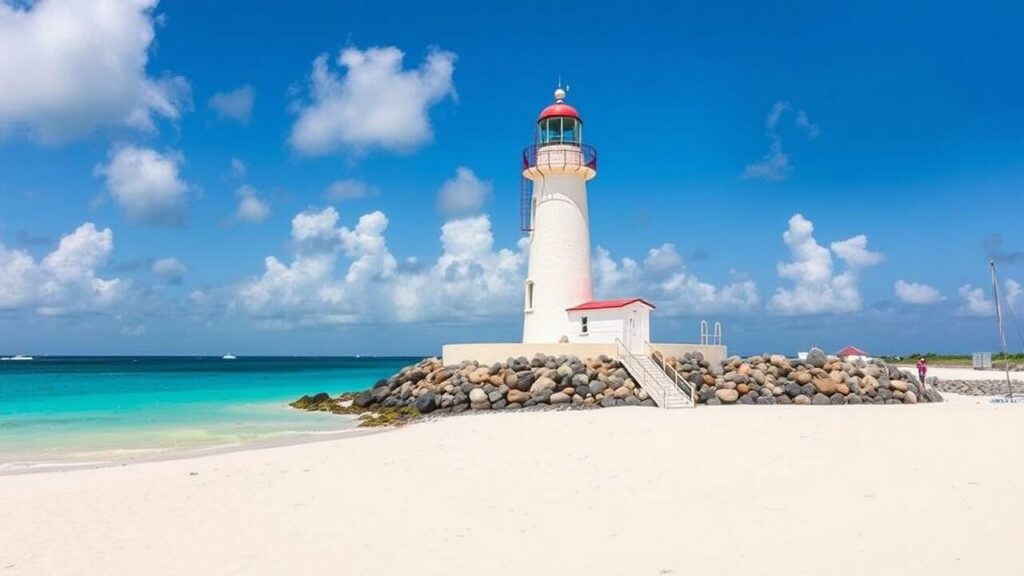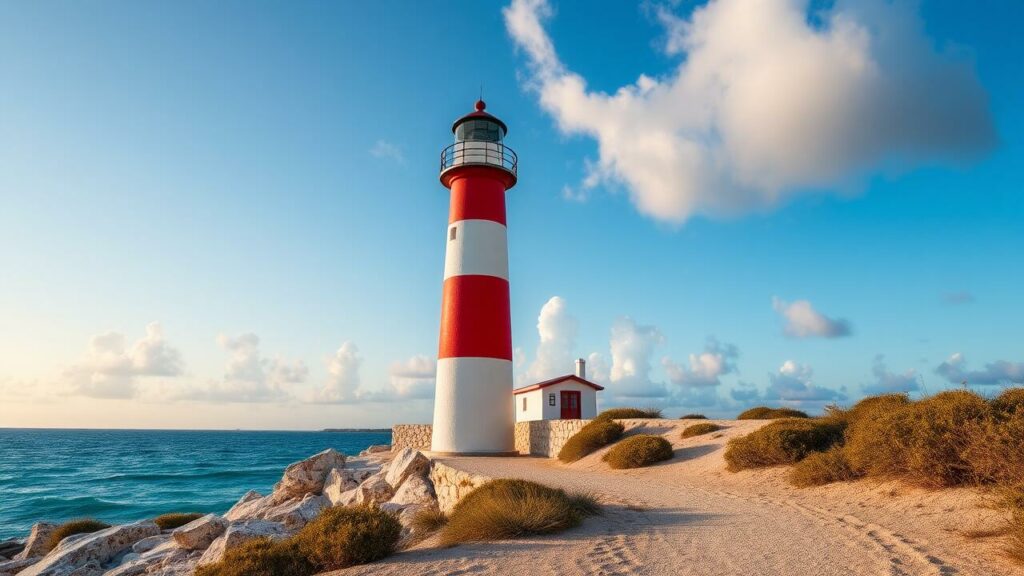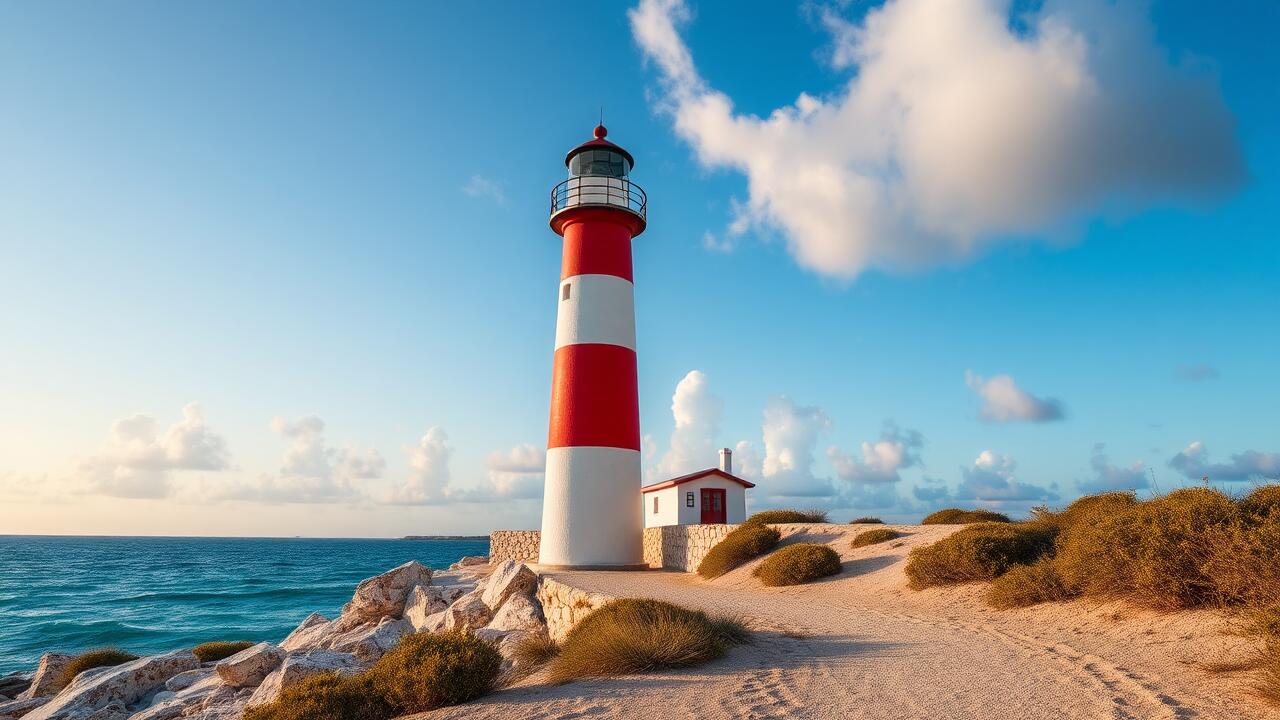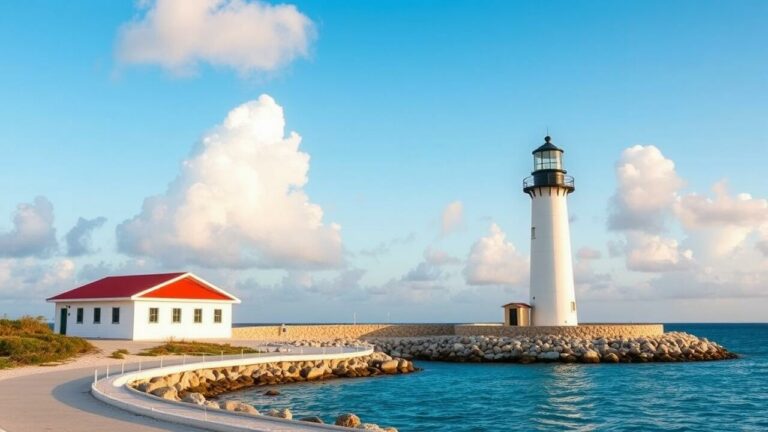The History of Aruba Board Walk Lighthouses
Table Of Contents
Discovering the History of Aruba Board Walk Lighthouses
Key Takeaways
- Overview of Aruba’s maritime legacy and its significance to the region
- Transformation of lighthouse architecture in Aruba over time
- Prominent beacons situated along the Aruba promenade
- Significant milestones in the advancement of Aruba’s lighthouses
- Influence of lighthouses on Aruba’s culture and community
The History Of Aruba Board Walk Lighthouses | Overview of Aruba’s Maritime Heritage
The History of Aruba Board Walk Lighthouses is a testament to the island’s maritime heritage and its navigational significance. Among the prominent structures, the California Lighthouse stands as a historical landmark, attracting both locals and tourists. The Seroe Colorado Lighthouse, another vital beacon, illustrates the role lighthouse keepers played in ensuring safe passage for seafarers around the rugged coastline. These lighthouses contributed profoundly to the development of Aruban culture, reflected in local folklore and the establishment of the Historical Museum of Aruba, which showcases artifacts connected to these maritime sentinels. With their striking designs, some even likened to the Eiffel Tower, these lighthouses serve as enduring symbols of the Aruban spirit and resilience, uniting Arubans in their appreciation for their navigational history.
The History of Aruba Board Walk Lighthouses | Significance of Lighthouses in Navigation
Lighthouses have served as vital beacons for navigation throughout The History of Aruba Board Walk Lighthouses, guiding sailors safely along the coast. These towering structures acted as landmarks, helping to prevent shipwrecks and ensuring smooth passage through the often treacherous waters. The unique architectural designs of these towers captivate visitors, with features like balconies that offer stunning views of the surrounding landscape. The role of these lighthouses extends beyond mere functionality; they also contribute to the cultural heritage of Aruba, often showcased in historical museums that celebrate the island’s maritime legacy.
As Aruba’s maritime history evolved, so did the significance of its lighthouses. Each beacon represents not just a point of reference for sailors, but also a testament to the skill of the architects who created them. These historical landmarks along the boardwalk continue to draw attention from both locals and tourists alike, symbolizing the island’s rich past. Daylight reveals the majesty of these iconic structures, prompting many to explore the fascinating stories woven into The History of Aruba Board Walk Lighthouses.
The Role of the Aruba Board Walk in Lighthouse Preservation
The Aruba Board Walk serves as a vital link connecting the island’s iconic lighthouses with visitors eager to explore the history of Aruba Board Walk Lighthouses. This scenic route offers a blend of sightseeing opportunities, including views of the historical landmarks and the stunning natural bridge. As tourists stroll along the boardwalk, they encounter well-preserved canal houses and the magnificent staircase leading up to the California Lighthouse. This experience enhances the understanding of Aruba’s maritime heritage while celebrating the integral role these lighthouses play in the community’s identity.
Preservation efforts along the boardwalk ensure that the lighthouses remain not only functional but also rich in cultural significance. The lanterns that once guided sailors are a testament to the craftsmanship of the time, while the nearby city walls reveal stories of Aruba’s past. As visitors engage with the site, they often express the desire to learn about local currency, like the Aruban florin, which reflects the island’s vibrant culture. These elements underscore the importance of maintaining the lighthouses for future generations, allowing them to appreciate the history of Aruba Board Walk Lighthouses while enjoying the beauty of the surrounding landscape during events like daylight savings.
- The boardwalk offers guided tours to educate visitors about lighthouse history.
- Preservation projects help maintain the structural integrity of the lighthouses.
- Local artists often showcase their work along the boardwalk, enhancing cultural engagement.
- Community events celebrate the lighthouses, fostering public interest in their upkeep.
- Tourism generated by the boardwalk supports local businesses and conservation efforts.
- Environmental initiatives along the walk promote sustainable tourism practices.
- Signage provides historical context, enriching the visitor experience and encouraging deeper connections.
The Evolution of Lighthouse Design in Aruba
Lighthouses along the Aruba Board Walk showcase a fascinating evolution that reflects the island’s rich maritime history. The design of these structures has changed significantly, influenced by the needs of navigation and advancements in technology. Early lighthouses, often simple in structure, guided boats along the coastline, ensuring safe passage across the ocean for steamships and other vessels. Over time, these buildings transformed into more elaborate designs, sometimes resembling grand mansions, which have become iconic tourist attractions. Museums now celebrate these landmarks, emphasizing their significance in preserving the island’s cultural heritage and adventurous spirit found on the east coast. The History of Aruba Board Walk Lighthouses serves as a testament to the community’s dedication to maritime safety and heritage.
Architectural Styles of Early Lighthouses
Early lighthouses along the Aruba Board Walk reflect a blend of practicality and artistry. The iconic lighthouses, such as California Lighthouse, showcase architectural styles influenced by the region’s cultural heritage. These structures were designed to endure the harsh maritime environment while providing essential navigation support for vessels. Notable lighthouses served as beacons for sailors, guiding them safely to shore. The History of Aruba Board Walk Lighthouses is interwoven with local landmarks, including the nearby Alto Vista Chapel, which adds to the charm of the area.
Electricity transformed lighthouse operations in the 20th century, enabling longer ranges and brighter signals. The preservation of artifacts linked to these early structures provides insights into their historical significance. Engaging in a lighthouse tour allows visitors to experience the rich maritime history firsthand, capturing stunning photography opportunities along the scenic boardwalk. From the oldest to the last lighthouse built, the architectural evolution remains a testament to Aruba’s dedication to preserving its maritime legacy. The History of Aruba Board Walk Lighthouses highlights the importance of these structures in shaping the island’s identity and navigational safety.
Modern Innovations in Lighthouse Construction
Recent advancements in lighthouse construction have transformed the way these structures are designed and maintained along the Aruba Board Walk. The iconic California Lighthouse stands as a testament to modern engineering, combining aesthetic appeal with functional advancements. Guided lighthouse tours highlight features that include energy-efficient lighting systems and enhanced safety measures. The integration of technology into these structures ensures that they remain vital navigational aids for mariners, while the historical context of The History of Aruba Board Walk Lighthouses is preserved.
Innovative designs are evident in the newer installations, such as the Vista Chapel Lighthouse, which reflects both modernity and tradition. The popularity of destinations like the White Lighthouse Restaurant demonstrates the cultural significance of these landmarks. As visitors explore the lighthouse directory index, they encounter multiple lighthouses that illuminate Aruba’s maritime heritage. The journey also pays tribute to the legacy of the first lighthouse keeper, underlining how new construction techniques complement the rich history of lighthouses along Aruba’s dazzling shores, especially at picturesque spots like Aruba Sunset Beach.
| Lighthouse Name | Location | Construction Year | Height (meters) | Energy Source |
|---|---|---|---|---|
| California Lighthouse | Aruba | 1910 | 30 | Solar-powered LED |
| Vista Chapel Lighthouse | Aruba | 2020 | 25 | Electric with backup generator |
| White Lighthouse Restaurant | Aruba | 1995 | 20 | Solar panels |
| Aruba Sunset Beach Lighthouse | Aruba | 2015 | 22 | Hybrid solar and wind |
Notable Lighthouses along the Aruba Board Walk
Aruba’s coastal landscape is adorned with several historic beacons that navigate both the waters and the cultural narrative of the island. The History of Aruba Board Walk Lighthouses reveals how these structures, including the iconic California Lighthouse, serve as a monument to former Aruban generations and their maritime endeavors. Nearby, the small hotel Aruba and the Aruba Ecury House capture the spirit of well-to-do Arubans who have long appreciated these landmarks. Enthusiasts can explore the significance of these lighthouses through resources like arubawalkingtours.com, which offers insights into the captivating stories behind them. Similar to the Eiffel Tower in its iconic status, the lighthouses are a testament to Aruba’s rich heritage and the efforts of the Monument Fund Aruba to preserve these treasures for future generations. The Westpunt Aruba area, with its picturesque scenery, further enhances the allure of these coastal sentinels, making them a vital part of both navigation and local folklore.

California Lighthouse: A Historical Landmark
The California Lighthouse stands as a significant element in The History of Aruba Board Walk Lighthouses. Constructed in 1914, this towering structure served as a vital light beacon for ships navigating the waters surrounding Aruba. Originally an unlit beacon, it transitioned to become a guiding light and a marker for maritime safety. The lighthouse’s strategic location near the 1980s boardwalk has made it a focal point for vacation houses and boardwalk hotels, drawing countless visitors seeking a glimpse of Aruba’s maritime heritage.
Today, the California Lighthouse is not only a reminder of Aruba’s nautical past but also a historical museum attracting both locals and tourists. The site serves as an educational platform for Aruban children and museum visitors alike, providing insights into the importance of lighthouses in navigation. Its enduring charm enhances the allure of the boardwalk vacation retreat, reflecting the rich tapestry of The History of Aruba Board Walk Lighthouses as a vital part of the island’s cultural identity.
Pedernales Lighthouse: Its Unique Characteristics
The Pedernales Lighthouse stands as a notable example of The History of Aruba Board Walk Lighthouses. This cylindrical tower, with its striking white and red stripes, is a monumental building that attracts many visitors. Located near boardwalk property, it serves not only as a navigational aid but also as a historic site representing Aruba’s maritime heritage. Close to the lighthouse, one can find an archaeological museum that showcases the island’s rich history, making it a perfect destination for those interested in exploring historical attractions.
Visitors often engage in excursions that highlight the unique characteristics of this remarkable building. The Pedernales Lighthouse, alongside other historic sites in the area, adds to the charm of the quaint community museum nearby. As one of the iconic landmarks along the boardwalk, it draws attention for its architectural beauty and significance. The combination of scenic views and historical context makes the Pedernales Lighthouse a key part of The History of Aruba Board Walk Lighthouses.
Key Events in the Development of Aruba’s Lighthouses
The establishment of Aruba’s lighthouses marks a pivotal moment in The History of Aruba Board Walk Lighthouses, shaping both navigation and the coastal landscape. The early history of these structures highlights their role as prominent landmarks for sailors, guiding them safely past treacherous waters. Nearby attractions, such as the train museum, enhance the experience for visitors exploring the area. Early morning strolls along the boardwalk reveal the stunning architecture of these lighthouses, featuring unique elements like a double balcony and a spiraling staircase. The octagonal prism stone design of some lighthouses contributes to their allure, while the monumental mansion nearby offers an insight into the island’s maritime legacy, ensuring that the lighthouses remain cherished attractions for generations to come.

The Establishment of the First Lighthouses
The establishment of the first lighthouses along Aruba’s coastline marked a significant milestone in maritime navigation. Visitors embarking on city walks can admire these historical structures while enjoying scenic strolls beside the water. The History of Aruba Board Walk Lighthouses reveals how these buildings served as crucial beacons for sailors, guiding them safely to shore. Fort houses nearby, such as those at the Hyatt Regency Resort, add to the allure of the area, making it a popular spot for sightseeing tours.
Constructed to enhance maritime safety, the early lighthouses were strategically positioned to be visible from the sea, ensuring that passing ships could navigate the waters safely. Walking along the boardwalk, visitors can immerse themselves in the rich maritime heritage evident at locations like Hudishibana Aruba. The History of Aruba Board Walk Lighthouses showcases how these structures have become integral to the island’s identity, reflecting both its cultural significance and architectural evolution.
Major Renovations and Restorations
Renovations of Aruba’s lighthouses reflect the island’s commitment to preserving its maritime heritage. The History of Aruba Board Walk Lighthouses highlights the uniqueness of structures like the California Lighthouse, which stands as a guide for sailors navigating the surrounding waters. The restoration efforts often blend modern aesthetics with historical significance, ensuring that these landmarks remain vital places for both locals and tourists. The transformation of nearby areas, such as the conversion of dutch canal houses into vibrant establishments, enhances the overall experience for visitors enjoying sunset views against the backdrop of these iconic lights.
The emphasis on restoration has also led to the creation of new building designs that harmonize with the architectural styles of the past. With daylight savings starting, the lighthouses illuminate the coastline, serving as breathtaking symbols of Aruba’s maritime culture. The coral pyramid structure and the green mansion nearby offer additional layers of intrigue, drawing attention to the rich history of the island. As maintaining these iconic towers continues, the connection between the islands’ past and present remains solid, allowing The History of Aruba Board Walk Lighthouses to thrive in the collective memory of the island’s residents and visitors.
The Cultural Impact of Lighthouses on Aruba
Lighthouses play a significant role in shaping the cultural narrative of Aruba, intertwining with its maritime heritage and spiritual history. The History of Aruba Board Walk Lighthouses reveals how these structures, often built on octagonal stone bases, serve as historical monuments that attract visitors seeking breathtaking island views. The California Lighthouse, a famous attraction, stands as a testament to Aruba’s navigational past, guiding sailors along coral shorelines. The installation of electrical infrastructure has modernized these beacons, yet they continue to evoke a sense of nostalgia, reminding locals and tourists alike of their first sight of the island. Tales surrounding these lighthouses, including the whimsical story of the baby bridge, enrich the cultural tapestry of Aruba, further emphasizing their importance in the collective memory of its people.
- Lighthouses serve as iconic symbols of Aruba’s maritime identity.
- They are often featured in local art and photography, attracting creativity.
- Many festivals and cultural events celebrate the history and stories of lighthouses.
- Lighthouses have become popular tourist destinations, contributing to local economies.
- They are integral to the local folklore and storytelling traditions among residents.
- Educational tours often include visits to lighthouses, spreading awareness of their historical significance.
- The preservation of lighthouses helps maintain Aruba’s cultural heritage for future generations.
Lighthouses in Local Folklore and Legends
The History of Aruba Board Walk Lighthouses is interwoven with local folklore that speaks to the island’s maritime past. Tales of sailors embarking on a perilous voyage often include the stories of these towering structures. Legends describe how ships would navigate treacherous waters guided by the steadfast light of the lighthouses, transforming them into vital outposts for seafarers. These buildings became symbols of safety, where weary travelers could find refuge, and their light would shine brightly as a beacon of hope.
Local folklore often portrays the lighthouses as guardians of the sea, imbued with stories of lost sailors and ghostly apparitions. The history surrounding these structures adds depth to their significance in the community. Guided tours along the boardwalk reveal not only the architectural beauty of each lighthouse but also the rich heritage that surrounds them. Each location has its own narrative, where water meets light, creating an enchanting backdrop rich in culture and history.
Conclusion
The History of Aruba Board Walk Lighthouses reflects the island’s rich maritime history and cultural heritage. Each lighthouse along the boardwalk serves as a historical house that tells the story of navigation and maritime safety throughout the years. Visitors on a trip to Aruba can spot these iconic landmarks and learn about their significance in the past. A tour of the Aruba Board Walk offers an engaging experience, allowing travelers to immerse themselves in the tales of sailors and coastal navigation. Bon dia Aruba awaits those keen to explore this remarkable aspect of the island’s history, as time spent in the presence of these lighthouses deepens the understanding of Aruba’s vibrant maritime legacy.
FAQS
What is the significance of the iconic water tower in Aruba concerning the adventure of the boardwalk boutique hotel and its history?
The iconic water tower in Aruba, dating back to the 1980s, is a key feature of the boardwalk boutique hotel area, offering visitors a unique glimpse into the historical charm of Arubaans culture. The boardwalk is an adventure in itself, providing access to local attractions, including references to the famous California lighthouse. As for daylight savings starts, visitors can enjoy those sunny days with a light that doesn’t seem stuck in time, much like the lamp that adorns the tower, enhancing the area’s appeal.
What can you tell me about the history of the Fingal lighthouse on the 1980’s boardwalk in Nacional Aruba, especially regarding the event when the light got stuck?
The Fingal lighthouse, located along the 1980’s boardwalk in Nacional Aruba, has a fascinating history tied to its functionality and significance. There was a notable incident where the light got stuck, which affected navigation for local fishermen and boats. This lighthouse has not only served as a critical navigational aid but has also become a beloved landmark for visitors enjoying the area.
What events led to the memorable incident of the light stuck at the lighthouse on the 1980’s boardwalk in Aruba?
The memorable incident of the light stuck at the lighthouse on the 1980-s boardwalk occurred during a storm when high winds and rain caused technical malfunctions. This resulted in the lighthouse’s beacon becoming inoperable for several hours, which prompted a quick response from local authorities and added to the lore surrounding the 1980-s boardwalk and its historical significance.
How has the construction of the boardwalk in Aruba influenced tourism in the region?
The construction of the boardwalk in Aruba has significantly influenced tourism by offering a scenic walkway that enhances visitor experiences, encourages outdoor activities, and connects various attractions along the coastline, ultimately contributing to the growth of the local economy and the popularity of Aruba as a travel destination.
How do the historical lighthouses along the Aruba boardwalk enhance the visitor experience for tourists exploring the island?
The historical lighthouses along the Aruba boardwalk significantly enhance the visitor experience by providing a scenic backdrop for tourists exploring the island. These landmarks not only serve as navigational aids but also offer captivating stories related to Aruba’s maritime history, enriching the overall journey for those who stroll along the boardwalk.







